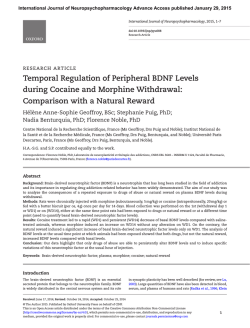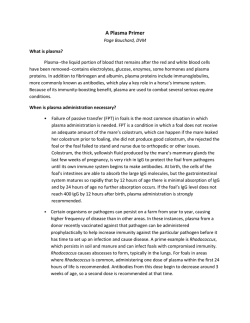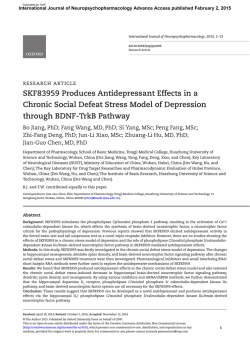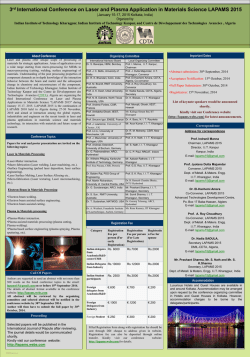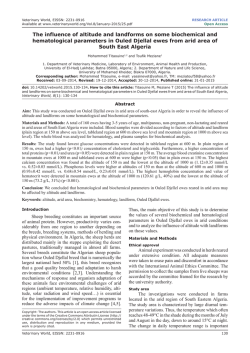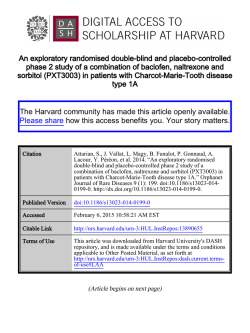
The Role of BDNF, Leptin, and Catecholamines in Reward Learning
International Journal of Neuropsychopharmacology Advance Access published January 31, 2015 International Journal of Neuropsychopharmacology, 2015, 1–8 doi:10.1093/ijnp/pyu092 Research Article research article The Role of BDNF, Leptin, and Catecholamines in Reward Learning in Bulimia Nervosa Philipp Homan, MD, PhD; Simona Grob, MSc; Gabriella Milos, MD; Ulrich Schnyder, MD; Anne Eckert, PhD; Undine Lang, MD, PhD; Gregor Hasler, MD Department of Molecular Psychiatry, University Hospital of Psychiatry, University of Bern, Switzerland (Drs Homan and Hasler); Department of Psychiatry and Psychotherapy, University Hospital, Zurich, Switzerland (Dr Grob, Drs Milos and Schnyder); Neurobiology Laboratory for Brain Aging and Mental Health, Psychiatric University Clinics Basel, Switzerland (Dr Eckert); Psychiatric University Clinics Basel, Switzerland (Dr Lang). Correspondence: Philipp Homan, MD, PhD, Department of Molecular Psychiatry, University Hospital of Psychiatry, University of Bern, Bolligenstrasse 111, 3000 Bern, Switzerland ([email protected]). Abstract Background: A relationship between bulimia nervosa and reward-related behavior is supported by several lines of evidence. The dopaminergic dysfunctions in the processing of reward-related stimuli have been shown to be modulated by the neurotrophin brain derived neurotrophic factor (BDNF) and the hormone leptin. Methods: Using a randomized, double-blind, placebo-controlled, crossover design, a reward learning task was applied to study the behavior of 20 female subjects with remitted bulimia nervosa and 27 female healthy controls under placebo and catecholamine depletion with alpha-methyl-para-tyrosine (AMPT). The plasma levels of BDNF and leptin were measured twice during the placebo and the AMPT condition, immediately before and 1 hour after a standardized breakfast. Results: AMPT–induced differences in plasma BDNF levels were positively correlated with the AMPT–induced differences in reward learning in the whole sample (P = .05). Across conditions, plasma brain derived neurotrophic factor levels were higher in remitted bulimia nervosa subjects compared with controls (diagnosis effect; P = .001). Plasma BDNF and leptin levels were higher in the morning before compared with after a standardized breakfast across groups and conditions (time effect; P < .0001). The plasma leptin levels were higher under catecholamine depletion compared with placebo in the whole sample (treatment effect; P = .0004). Conclusions: This study reports on preliminary findings that suggest a catecholamine-dependent association of plasma BDNF and reward learning in subjects with remitted bulimia nervosa and controls. A role of leptin in reward learning is not supported by this study. However, leptin levels were sensitive to a depletion of catecholamine stores in both remitted bulimia nervosa and controls. Keywords: BDNF, leptin, reward, catecholamines, bulimia nervosa, alpha-methyl-para-tyrosine Introduction Bulimia nervosa (BN) is a complex eating disorder and its etiology is still largely unknown. A biological basis is widely accepted, and therefore an extensive effort has been taken to study neurotransmitters, neuropeptides, and neuromodulators Received: August 8, 2014; Revised: October 28, 2014; Accepted: October 30, 2014 © The Author 2015. Published by Oxford University Press on behalf of CINP. This is an Open Access article distributed under the terms of the Creative Commons Attribution Non-Commercial License (http://creativecommons.org/licenses/by-nc/4.0/), which permits non-commercial re-use, distribution, and reproduction in any medium, provided the original work is properly cited. For commercial re-use, please contact [email protected] 1 2 | International Journal of Neuropsychopharmacology, 2015 implicated in the regulation of eating behavior. Eating behavior is influenced not only by metabolic but also nonmetabolic factors (Monteleone and Maj, 2013), including cognition, emotion, and reward. Specifically, food intake can be triggered by reward-related processes even in the absence of a homeostatic requirement. Appetite-regulating substances such as brain derived neurotrophic factor (BDNF) and leptin have been shown to additionally mediate the rewarding aspects of food (Monteleone and Maj, 2013) by promoting the food intake of highly rewarding food rich in sugar or fat. In line with this, BN can be conceptualized as a disease where binge eating is aimed at reducing the patient’s negative emotions by increasing food-derived feelings of pleasure. Negative emotions might be associated with a dysfunctional processing of rewards. Consequently, several lines of evidence support a relationship between BN and alterations in reward-related behavior (Harrison et al., 2010; Wagner et al., 2010; Grob et al., 2012). We have previously shown a dopamine-related deficit in reward learning in subjects with remitted BN (rBN) (Grob et al., 2012). Critically, the dopaminergic dysfunctions in the processing of reward-related stimuli have been shown to be modulated by BDNF and leptin. BDNF, a neurotrophin involved in neuronal outgrowth and differentiation, synaptic connectivity, and neuronal repair, plays a role in dopaminergic neurons within the mesolimbic reward pathway, including the ventral tegmental area (VTA) and their projections to the nucleus accumbens (NAc) and medial prefrontal cortex (Rios, 2013). The mesolimbic reward pathway is involved in what has been termed hedonic feeding, that is, the intake of highly rewarding food even in the absence of a metabolic requirement (Bassareo and Di Chiara, 1999; Rada et al., 2005). Within this circuitry, BDNF is expressed in the VTA and medial prefrontal cortex and is anterogradely transported to the NAc where little or no BDNF is expressed (Rios, 2013). Specifically, BDNF levels in dopaminergic cells within the VTA/NAc pathway seem to be related to the neuroadaptive changes following reward responses in animal models (Blochl and Sirrenberg, 1996; Horger et al., 1999; Cordeira et al., 2010). In humans, there is initial evidence suggesting that the decreased BDNF activity in carriers of a valinemethionine polymorphism at codon 66 results in a decreased dopamine tone in the NAc (Pecina et al., 2014). Leptin, on the other hand, an adipocyte-derived hormone involved in the regulation of energy balance (Blundell et al., 2001), has also been reported to modulate reward-related behavior. Within the mesolimbic pathway, leptin receptors have been detected on the VTA dopaminergic neurons (Scott et al., 2009), suggesting that leptin decreases the firing of mesolimbic dopaminergic neurons as well as the dopamine release and concentrations in the NAc (Krugel et al., 2003). This might ultimately lead to a negative modulation of reward-related behaviors in animals (Carroll et al., 1984; Fulton et al., 2000; Cowley et al., 2001; Shalev et al., 2001; Figlewicz et al., 2006; Davis et al., 2011) and humans (Farooqi et al., 2007). The current study aimed at elucidating the roles of BDNF, leptin, and dopamine in reward-related behavior of rBN subjects. To this end, we used a reward learning task to study the participants’ behavior as a function of reward (Pizzagalli et al., 2005) during a pharmacological challenge with placebo and alpha-methyl-para-tyrosine (AMPT) (Berman et al., 1999) that has been shown to deplete central dopamine and norepinephrine stores (Stine et al., 1997; Verhoeff et al., 2003). In addition, we measured the plasma levels of BDNF and leptin twice during the placebo and AMPT conditions, immediately before and 1 hour after a standardized breakfast. Since we were not aware of any studies that have measured the relationship of BDNF and leptin in reward-related behavior of rBN subjects, the corresponding analyses were performed in an exploratory fashion. Previous studies did, however, measure the plasma and serum levels of BDNF and leptin in subjects with BN, but the results were inconsistent for BDNF (Nakazato et al., 2003; Monteleone et al., 2005; Mercader et al., 2007; Saito et al., 2009; Yamada et al., 2012), whereas plasma leptin levels were found to be decreased (Jimerson et al., 2000; Monteleone et al., 2000a 2000b). Consequently, and because of the fact that our study differed from previous studies by measuring nonmedicated BN subjects that were in remission, the BDNF and leptin plasma analyses were also performed in an exploratory fashion. Methods Participants We used the data from the study sample described in (Grob et al., 2012) that also overlaps with other previously published results (Grob et al., 2013; Homan et al., 2013). We recruited females aged 19 to 39 years who had previously met DSM-IV criteria for BN and had been in remission from BN for at least 6 months (n = 20) or who had no history of any psychiatric disorder and no major psychiatric condition in first-degree relatives (control subjects; n = 30). Subjects with rBN had no recurrent episodes of binge eating and no recurrent inappropriate compensatory behavior to prevent weight gain during the last 6 months. The screening visit included a diagnostic Structured Clinical Interview for DSM-IV with a psychiatrist and a physical examination. To obtain comparable samples, participants for both study groups were recruited by advertisements in local newspapers and announcements at the University of Zurich and the Swiss Federal Institute of Technology Zurich. Exclusion criteria included current Axis I psychiatric disorders, a lifetime diagnosis of psychosis, major medical or neurological illness, psychoactive medication exposure within 6 months, pregnancy, lifetime history of substance dependence, and suicidal ideation or a history of suicide attempts. All subjects gave written informed consent before participation. The study protocol was approved by the ethics committee of the Canton Zurich (Kantonale Ethikkommission Zürich). Experimental Design This was a randomized, double-blind, placebo-controlled, crossover study during which all subjects underwent 2 identical sessions separated by at least 7 days wherein they received either AMPT or placebo. Each session included a 2-day stay at the Department of Psychiatry and Psychotherapy of the University Hospital of Zurich. One-bed rooms with a separate lavatory were available on a separated floor for all participants, and they had no contact with other hospitalized subjects. None of the rBN subjects had been previously hospitalized at this Department of Psychiatry and Psychotherapy. Participants received regular standardized meals during the hospital sessions. Each subject was contacted daily by telephone for 3 subsequent days after each trial for follow-up interviews. To avoid any risk of adverse reaction, body weight-adjusted oral doses of AMPT of 40 mg/kg, to a maximum of 4 g over 22 hours (at 9:00 am, 12:00 pm, and 7:00 pm on day 1 and 7:00 am on day 2), were administered. During sham depletion, subjects received inactive placebo on day 1 at 9:00 am and 12:00 pm and 25 mg oral Homan et al. | 3 diphenhydramine on day 1 at 7:00 pm and on day 2 at 7:00 am to imitate the mild sedation effect that is often induced by AMPT. To prevent formation of crystalluria during AMPT administration, the subjects were instructed to drink at least 2 L of water daily. Possible adverse reactions were assessed regularly (26, 30, 54, 78, and 102 hours after the first AMPT/placebo administration) during hospitalization by medical examination, including blood pressure measurement, and for 3 subsequent days after each trial session as part of the daily telephone follow-up interview. Blood Samples During each session, blood samples were drawn before and at 26 hours after the first AMPT dose (because the depletion effect is evident from 24 hours after the first AMPT dose) in order to measure plasma BDNF and leptin levels. The first sample was drawn immediately before and the second one within 1 hour after eating a regular standardized breakfast. Blood samples were drawn before the reward learning task. Plasma BDNF levels were measured using a BDNF Emax Immunoassay Kit (Promega, Switzerland; specificity: cross-reactivity to related neurotrophins <3%; sensitivity: detects a minimum of about 15 pg/mL). Plasma leptin concentrations were measured using a commercial Radioimmunoassay (Millipore, Millipore Corporation, Billerica, MA; specificity: 100%; sensitivity: detects a minimum of 1.0 ng/mL). Behavioral Assessment Depressive symptoms were assessed with the MontgomeryÅsberg Depression Rating Scale and the Hamilton Scale of Depression. In addition, participants completed various selfreport ratings, including the German version of the Eating Disorder Examination-Questionnaire (Hilbert, 2006). Symptoms were assessed immediately before the first AMPT/placebo dose (prechallenge) and at 26, 30, 54, 78, and 102 hours after the first dose. Reward Learning Task Thirty hours after the first AMPT/placebo administration, subjects participated in a 25-minute probabilistic reward task presented on a PC using E-prime software that has been previously described (Grob et al., 2012). Briefly, participants were instructed that the goal of that task was to win as much money as possible. The task included 300 trials divided into 3 blocks of 100 trials. An asymmetric reinforcement ratio was used to induce a response bias, that is, subjects received a reward 3 times more frequently for correct identification of a rich stimulus than for correct identification of a lean stimulus. Each participant was exposed to the same reward ratio. Reward learning was defined as the difference in response bias between Block 1 and Block 3 (Pizzagalli et al., 2005 2008; Bogdan and Pizzagalli, 2006). Statistical Analysis Full factorial linear mixed models with restricted maximum likelihood estimation were applied to determine the effects of treatment, diagnosis, and treatment-by-diagnosis on BDNF and leptin. An additional factor time was included as fixed effect to account for the 2 measurements in each condition. In all models, a various components or compound symmetry covariance structure, chosen considering the lowest Akaike’s Information Criterion, was appropriate for the repeated measures. Subject number and treatment sequence were included as random effects in all models. To evaluate the relationship between alterations induced by catecholamine depletion in hormone levels and reward learning, additional Spearman rank correlation coefficients were calculated. Therefore, the differences in plasma BDNF and leptin levels between the second and first measurement were calculated for each subject and each condition. The difference obtained from the AMPT condition was then subtracted from the difference obtained from the placebo condition, reflecting the AMPT-induced change in plasma levels. In the same manner, the differences between the reward learning scores obtained for each subject in the AMPT session vs the placebo session were calculated to reflect the magnitude of AMPT-induced effect on reward learning. We also assessed the effect that feeding might have had on the relationship between plasma BDNF and leptin levels and reward learning by calculating the difference of plasma BDNF and leptin levels between 10 hours and 7 hours in the placebo condition in each subject and by correlating these differences with the results of the reward learning task in the placebo condition with a Spearman rank correlation. To account for the possible influence of past episodes of anorexia nervosa, all analyses were repeated excluding patients with a history of anorexia nervosa. The significance threshold for these contrasts was set at alpha = 0.05 (2-tailed). SAS 9.3 (SAS Institute, Cary, NC, http://www.sas.com) was used for all analyses. Means are reported with their associated standard deviations. Results Three control subjects had to be excluded from the study because of inadequate or missing (eg, insufficient quantity or hemolysis) blood samples in all measurements, leaving 20 rBN subjects and 27 healthy controls for the measurements of plasma BDNF and leptin levels. Four rBN subjects and 2 controls had to be excluded from the correlational analysis of reward learning, BDNF, and leptin because of missing trials in the reward learning task, leaving 16 rBN subjects and 25 healthy controls for the correlational analysis. The clinical and demographic characteristics of study participants, including baseline parameters, are detailed in Table 1. The rBN subjects had significantly more depressive symptoms at baseline vs the healthy controls as measured with the Hamilton Scale of Depression (t [1, 45] = 2.51, P = .02), and they had histories of significantly lower minimal body mass indexes (BMIs) (t [1, 45] = -2.1, P = .04). The rBN subjects retained a significantly greater number of bulimic symptoms at study entry compared with the healthy controls (t [1, 45] = 2.53, P = .01). Plasma leptin levels at the first measurement at 7 hours during the placebo condition were positively correlated with BMI in subjects with rBN (r = 0.88, P < .0001), and this correlation approached significance in controls (r = 0.34, P = .08). This correlation was also significant for the whole study sample (r = 0.63, P < .0001). Effects of AMPT on reward learning as well as depressive and bulimic symptoms have been previously reported (Grob et al., 2012 2013). Briefly, rBN subjects showed significantly lower reward learning (diagnosis-effect; F [1, 76] = 10.66, P = .002) across conditions. In addition, there was a significant treatment-by-diagnosis interaction (F [1, 76] = 4.94, P = .03) that was attributable to significantly lower reward learning in rBN subjects compared with controls under AMPT (t [1, 76] = 3.88, P = .001). 4 | International Journal of Neuropsychopharmacology, 2015 Table 1. Demographic and Clinical Characteristics of Unmedicated Subjects with Remitted Bulimia Nervosa (rBN) and Healthy Controls Characteristic rBN (n = 20) Sex, n f/m Age, mean (SD), y BMI, mean (SD), kg/m2 BMI min, mean (SD), kg/m2 BMI max, mean (SD), kg/m2 Age at onset, mean (SD), y Educational level (SD), y Time in remission, mo Mean (SD) Range History of anorexia nervosa First-degree relative(s) with a history of bulimia nervosa, n First-degree relative(s) with a history of anorexia nervosa, n Remote (>1 y ago) history of alcohol abuse, n History of drug abuse, n Plasma BDNF concentration at first measurement under placebo, mean (SD), pg/mL Plasmal leptin concentration at first measurement under placebo, mean (SD), ng/mL MADRS score at first measurement, mean (SD) HAMD score at first measurement, mean (SD) EDE-Q score at first measurement, mean (SD) Controls (n = 27) P-value 20/0 29.1 (4.7) 21.7 (3.1) 17.2 (2.2) 24.0 (3.5) 15.5 (4.7) 16.5 (3.1) 27/0 28.5 (3.8) 22.2 (2.3) 19.3 (4.2) 22.7 (5.4) n. a. 17.3 (3.0) n.a. 0.65 0.47 0.04* 0.35 n.a. 0.4 31.9 (28.1) 6 – 84 7 2 2 2 2 3058.0 (1506.6) 12.7 (9.4) 2.0 (2.6) 1.0 (1.4) 6.3 (9.3) n. a. n. a. n.a. 0 0 0 1 2383.2 (1281.4) 13.1 (7.9) 1.0 (2.8) 0.3 (0.6) 1.7 (2.0) n.a. n.a. n.a. 0.2 0.2 0.2 0.6 0.08 0.81 0.19 0.02* 0.01* Abbreviations: BDNF, brain derived neurotrophic factor; BMI, Body Mass Index; BMI min, minimal Body Mass Index during disease; BMI max, maximal Body Mass Index during disease; EDE-Q, Eating Disorder Examination-Questionnaire; HAMD, Hamilton Scale of Depression; MADRS, Montgomery-Åsberg Depression Rating Scale; n.a., not applicable; * indicates a significant difference at P < .05. BDNF Concentrations in Plasma and Correlation with Reward Learning At the first measurement at 7 hours during the placebo condition, subjects with rBN had higher levels of BDNF compared with healthy controls at a trend level (t [1, 45] = 1.82, P = .08). Mean plasma levels of BDNF under catecholamine depletion and placebo are shown in Figure 1A. The plasma BDNF levels were significantly higher in rBN subjects compared with healthy controls across conditions (diagnosis effect; F [1, 181] = 10.71, P = .0010) (Figure 1B). In addition, plasma BDNF levels were significantly higher across groups and conditions at the first measurement at 7 hours after fasting compared with the second measurement at 10 hours after a standardized breakfast (time effect; F [1, 181] = 43.37, P < .0001). There was no effect of treatment (P = .99) and no treatment-by-diagnosis interaction (P = .35). After repeating the analysis excluding patients with a history of anorexia nervosa, the diagnosis effect decreased (F [1, 161] = 3.77, P = .05). The Spearman rank correlation between the AMPT-induced differences in plasma BDNF levels and the AMPT-induced differences in reward learning approached significance (rho = 0.3, P = .05) (Figure 1B). The correlation between meal-induced changes in plasma BDNF levels and reward learning under placebo was not significant (P > .1). After repeating the analysis excluding patients with a history of anorexia nervosa, this correlation was slightly stronger (rho = 0.33, P < .05). Repeating the analysis for each of the diagnostic groups separately did not reveal any significant results (all P > .05). Leptin Concentrations in Plasma and Correlation with Reward Learning At the first measurement at 7 hours during the placebo condition, no difference in plasma leptin levels between rBN subjects and controls was evident (P = .79). Mean plasma levels before and after catecholamine depletion are shown in Figure 1C. Under catecholamine depletion, the plasma leptin levels were significantly higher across groups (treatment effect; F [1, 181] = 12.78, P = .0004) (Figure 1C). Plasma leptin levels were significantly higher across groups and conditions at the first measurement at 7 hours after fasting compared with the second measurement at 10 hours after a standardized breakfast (time effect; F [1, 181] = 47.5, P <.0001) (Figure 1C). No diagnosis effect (P = .92) and no treatment-by-diagnosis interaction (P = .63) were evident. An additional analysis excluding patients with a history of anorexia nervosa did not change the results. The Spearman rank correlation between the AMPT-induced differences in plasma leptin levels and the AMPT-induced differences in reward learning was not significant (P = .37). The correlation between meal-induced changes in plasma leptin levels and reward learning under placebo was not significant (P > .1). An additional analysis excluding patients with a history of anorexia nervosa did not change the results. Repeating the analysis for each of the diagnostic groups separately did not reveal any significant results (all P > .05). Discussion The current study was the first to investigate the relationship of BDNF, leptin, and dopamine in reward-related behavior of rBN subjects and controls. We used a pharmacological challenge paradigm with AMPT to deplete central dopamine and norepinephrine stores. We found that the AMPT-induced differences in plasma BDNF levels were positively correlated at a trend level with the AMPT-induced differences in reward learning in the whole sample. At the first measurement under placebo, plasma BDNF levels were higher at a trend level in rBN subjects compared with controls. Across conditions, plasma BDNF levels were significantly higher in rBN subjects compared with controls. Plasma BDNF and leptin levels were significantly higher in the morning before breakfast compared with after a standardized breakfast across groups and conditions. The plasma leptin levels were higher under catecholamine depletion compared with placebo in the whole sample. Homan et al. | 5 Figure 1. Boxplots of plasma brain derived neurotrophic factor (BDNF) concentrations before and after catecholamine depletion in subjects with remitted bulimia nervosa (rBN) (n = 20) and healthy controls (n = 27). The first sample was drawn immediately before, the second one within 1 hour after eating a regular standardized breakfast. BN pre, rBN patients before treatment; BN post, rBN patients after treatment; HC pre, healthy controls before treatment; HC post, healthy controls after treatment. (B) Alpha-methyl-para-tyrosine (AMPT)-induced differences in plasma BDNF levels plotted against the AMPT-induced differences in reward learning in subjects with rBN and healthy controls. Reward learning was defined as the difference in response bias between Block 1 and Block 3 of a probabilistic reward task. The Spearman rank correlation between the AMPT-induced differences in plasma BDNF levels and the AMPT-induced differences in reward learning approached significance (rho = 0.3, P = .05). (C) Boxplots of plasma leptin concentrations before and after catecholamine depletion in subjects with rBN (n = 20) and healthy controls (n = 27). The first sample was drawn immediately before, the second one within 1 hour after eating a regular standardized breakfast. HC 7:00 am = healthy controls before eating a standardized breakfast; HC 10 am = healthy controls after eating a standardized breakfast; rB 7 am = rBN patients before eating a standardized breakfast; rB 10 am = rBN patients after eating a standardized breakfast. The current study investigated plasma BDNF and leptin levels in unmedicated subjects with rBN and assessed their association to reward-related behavior during an experimentally induced depletion of central dopamine and norepinephrine stores. We found a positive association at a trend level between the AMPT-induced differences in plasma BDNF levels and reward learning in the whole study population that is compatible with a function of BDNF in reward-related behaviors. It has been demonstrated that BDNF and its tyrosine kinase receptor are expressed in dopaminergic neurons of the VTA and that BDNF is anterogradely transported to the NAc (Numan and Seroogy, 1999), which suggests a role for BDNF in modulating reward. Specifically, BDNF levels in dopaminergic cells within the VTA/NAc pathway might be related to the neuroadaptive changes following reward responses in animal models. In line with this, BDNF stimulates the release of dopamine in mesencephalic neurons of rodents (Blochl and Sirrenberg, 1996), and BDNF infusions into the NAc of rats have shown that this dopamine release is associated with a facilitation of rewardrelated stimuli (Horger et al., 1999). In addition, recent work has shown that mutant mice depleted of central BDNF exhibited a marked decrease in the evoked release of dopamine in the NAc and dorsal striatum (Cordeira et al., 2010). Notably, the VTA-specific deletion of the BDNF gene resulted in increased ingestion of a palatable, high-fat diet but not of a standard diet. These results suggest a positive modulation of hedonic eating by BDNF through increasing mesolimbic dopaminergic activity. In humans, initial evidence suggests a BDNF effect of dopaminemediated responses to reward in the VTA/NAc pathway (Pecina et al., 2014). The positive association at a trend level of AMPTinduced changes in plasma BDNF levels and the corresponding changes in reward learning under a condition of experimentally 6 | International Journal of Neuropsychopharmacology, 2015 depleted dopamine as found in our study supports the view of a tight connection between BDNF, dopamine, and reward also in humans. With respect to the plasma BDNF levels, we found higher concentrations at the first measurement under placebo in rBN subjects compared with controls. Across all conditions, these levels were higher in rBN subjects compared with controls and higher in both groups under catecholamine depletion compared with placebo. Previous studies have found reduced BDNF concentrations in BN compared with controls (Nakazato et al., 2003; Monteleone et al., 2005; Yamada et al., 2012), but this reduction was not always significant (Saito et al., 2009) or even found in controls compared with BN (Mercader et al., 2007). Our study differed in an important aspect from the aforementioned studies in that we measured subjects with BN in remission that were off medication. This allowed for an investigation without potential medication confounds and during a period of experimentally induced eating disorder symptoms (Grob et al., 2013). During this relapse-like period, we did not observe a decrease of plasma BDNF concentrations; instead, the levels were higher in rBN compared with controls across conditions. Increased BDNF concentrations with respect to BN have previously been interpreted as high BDNF levels in the central nervous system that would alter eating behavior (Mercader et al., 2007). In line with this, BDNF infusions into the rodents brains have been reported to induce weight loss while increasing feeding and food retrieval (Lapchak and Hefti, 1992; Pelleymounter et al., 1995; MartinIverson and Altar, 1996). In addition, it has been found that mice with a heterozygous BDNF knockout display hyperphagia and obesity (Lyons et al., 1999; Kernie et al., 2000; Rios et al., 2001). However, it has been suggested that the site and dose of BDNF infusion has to be considered, since only intra-VTA but not NAc infusions produced weight loss in mice (Horger et al., 1999). Further, a recent study in anorexia nervosa, an eating disorder closely related to BN, has reported on different levels of BDNF depending on the stage of disease. Specifically, BDNF concentrations were significantly higher in recovered compared with underweight patients and increased with short-term weight gain (Zwipp et al., 2014). This might indicate that the higher plasma BDNF levels in rBN compared with controls found in our study might be a relevant factor in achieving remission. Our study is the first to report on a decrease between preprandial and postprandial plasma BDNF levels in rBN subjects and healthy controls. The interpretation of this finding is not straightforward, since BDNF has been suggested to induce appetite suppression and weight loss through a central mechanism in previous animal studies (Lapchak and Hefti, 1992; Pelleymounter et al., 1995; Martin-Iverson and Altar, 1996). In humans, genetic BDNF polymorphisms are linked to severe obesity (Yeo et al., 2004; Friedel et al., 2005; Gray et al., 2006; Beckers et al., 2008; Burns et al., 2010). Consequently, this finding challenges the current view that BDNF modulates appetite suppression (Unger et al., 2007). A possible explanation for this differential result in our study is that previous work has focused on the role of BDNF in obesity and corresponding overeating behavior, whereas the subjects assessed in the current study had BN in remission with a normal eating behavior. The current study also investigated the association of reward learning and plasma leptin levels. Although leptin has been reported to modulate reward-related behavior by decreasing the firing of mesolimbic dopaminergic neurons as well as dopamine release and concentrations in the NAc (Krugel et al., 2003), we did not find an association of reward learning and plasma leptin levels in the current study. We found that plasma leptin levels were comparable at the first measurement under placebo in both rBN and controls and that the increasing effect of the pharmacological manipulation with AMPT was evident in both groups. These results are in contrast to previous studies that have found reduced plasma and serum leptin levels in normalweight BN subjects (Jimerson et al., 2000; Monteleone et al., 2000a 2000b; Monteleone et al., 2002a 2002b). One of these studies has also measured BN subjects in remission with a mean remission time comparable with our study and has confirmed the reduction of leptin levels in this sample (Jimerson et al., 2000). Monteleone and Maj (2013) have recently reviewed the role of leptin in BN. Based on their own findings (Monteleone et al., 2000b; Monteleone et al., 2002a), these authors have suggested that the role of leptin as a peripheral signal of available energy stores seems to be preserved in subjects with BN, whereas its signal function of acute changes in the energy balance is lost (Monteleone and Maj, 2013). In line with this suggestion is our finding of a positive correlation of plasma leptin levels and BMI in subjects with rBN, which is also consistent with previous reports (reviewed in Monteleone and Maj, 2013). However, with respect to our conflicting findings of comparable plasma leptin levels in rBN and controls under placebo and higher levels under catecholamine depletion, it has to be considered that our study differed in an important aspect from the aforementioned studies, since we measured subjects with BN in remission during a pharmacological challenge with AMPT (Grob et al., 2013). The findings themselves might indicate that the plasma leptin levels are restored in remitted subjects with BN and are a relevant factor in achieving remission. The current study had some limitations that merit comment. Because of the relatively small sample size, the findings should be considered preliminary and should be replicated in larger samples in future studies. It should also be noted that the patients included in this study were in remission, so the findings may not necessarily apply to unremitted patients. The catecholamine-dependent association of plasma BDNF and reward learning was modest and only approached significance (P = .05). However, this effect was significant after excluding rBN subjects with a history of anorexia nervosa, suggesting that anorexia nervosa might be a confounder in this relationship. In addition, the fact that we measured peripheral and not central BDNF and leptin levels as well as the fact that AMPT might have had peripheral effects should be considered. It is thus possible that a peripheral modulation of BDNF and leptin levels caused by AMPT might have contributed to the present findings. Furthermore, it is important to note that the correlational analysis could not establish a causal relationship between AMPT-induced changes in plasma BDNF levels and reward learning. Finally, the specificity of our results was limited by the fact that AMPT reduces not only the synthesis of dopamine but also norepinephrine. Consequently, an influence of reduced norepinephrine on reward learning and BDNF and leptin levels cannot be entirely ruled out. In conclusion, the current study reports on preliminary findings that suggest a catecholamine-dependent association of plasma BDNF and reward learning in subjects with rBN and controls. A role of leptin in reward learning is not supported by this study. However, leptin levels were sensitive to a depletion of catecholamine stores in both rBN and controls. Acknowledgments This research was supported by the Swiss National Science Foundation Nr. 32003B-117763. Homan et al. | 7 We are grateful to M. Seiler for valuable help in organizing the biochemical analyses. Statement of Interest None. References Bassareo V, Di Chiara G (1999) Modulation of feeding-induced activation of mesolimbic dopamine transmission by appetitive stimuli and its relation to motivational state. Eur J Neurosci 11:4389–4397. Beckers S, Peeters A, Zegers D, Mertens I, Van Gaal L, Van Hul W (2008) Association of the BDNF Val66Met variation with obesity in women. Mol Genet Metab 95:110–112. Berman RM, Narasimhan M, Miller HL, Anand A, Cappiello A, Oren DA, Heninger GR, Charney DS (1999) Transient depressive relapse induced by catecholamine depletion: potential phenotypic vulnerability marker? Arch Gen Psychiatry 56:395–403. Blochl A, Sirrenberg C (1996) Neurotrophins stimulate the release of dopamine from rat mesencephalic neurons via Trk and p75Lntr receptors. J Biol Chem 271:21100–21107. Blundell JE, Goodson S, Halford JC (2001) Regulation of appetite: role of leptin in signalling systems for drive and satiety. Int J Obes Relat Metab Disord 25 Suppl 1:S29–34. Bogdan R, Pizzagalli DA (2006) Acute stress reduces reward responsiveness: implications for depression. Biol Psychiatry 60:1147–1154. Burns B, Schmidt K, Williams SR, Kim S, Girirajan S, Elsea SH (2010) Rai1 haploinsufficiency causes reduced Bdnf expression resulting in hyperphagia, obesity and altered fat distribution in mice and humans with no evidence of metabolic syndrome. Hum Mol Genet 19:4026–4042. Carroll ME, Stotz DC, Kliner DJ, Meisch RA (1984) Self-administration of orally-delivered methohexital in rhesus monkeys with phencyclidine or pentobarbital histories: effects of food deprivation and satiation. Pharmacol Biochem Behav 20:145– 151. Cordeira JW, Frank L, Sena-Esteves M, Pothos EN, Rios M (2010) Brain-derived neurotrophic factor regulates hedonic feeding by acting on the mesolimbic dopamine system. J Neurosci 30:2533–2541. Cowley MA, Smart JL, Rubinstein M, Cerdan MG, Diano S, Horvath TL, Cone RD, Low MJ (2001) Leptin activates anorexigenic POMC neurons through a neural network in the arcuate nucleus. Nature 411:480–484. Davis JF, Choi DL, Schurdak JD, Fitzgerald MF, Clegg DJ, Lipton JW, Figlewicz DP, Benoit SC (2011) Leptin regulates energy balance and motivation through action at distinct neural circuits. Biol Psychiatry 69:668–674. Farooqi IS, Bullmore E, Keogh J, Gillard J, O’Rahilly S, Fletcher PC (2007) Leptin regulates striatal regions and human eating behavior. Science 317:1355. Figlewicz DP, Bennett JL, Naleid AM, Davis C, Grimm JW (2006) Intraventricular insulin and leptin decrease sucrose selfadministration in rats. Physiol Behav 89:611–616. Friedel S, Horro FF, Wermter AK, Geller F, Dempfle A, Reichwald K, Smidt J, Bronner G, Konrad K, Herpertz-Dahlmann B, Warnke A, Hemminger U, Linder M, Kiefl H, Goldschmidt HP, Siegfried W, Remschmidt H, Hinney A, Hebebrand J (2005) Mutation screen of the brain derived neurotrophic factor gene (BDNF): identification of several genetic variants and association studies in patients with obesity, eating disorders, and attention-deficit/hyperactivity disorder. Am J Med Genet B Neuropsychiatr Genet 132B:96–99. Fulton S, Woodside B, Shizgal P (2000) Modulation of brain reward circuitry by leptin. Science 287:125–128. Gray J, Yeo GS, Cox JJ, Morton J, Adlam AL, Keogh JM, Yanovski JA, El Gharbawy A, Han JC, Tung YC, Hodges JR, Raymond FL, O’Rahilly S, Farooqi IS (2006) Hyperphagia, severe obesity, impaired cognitive function, and hyperactivity associated with functional loss of one copy of the brain-derived neurotrophic factor (BDNF) gene. Diabetes 55:3366–3371. Grob S, Pizzagalli DA, Dutra SJ, Stern J, Morgeli H, Milos G, Schnyder U, Hasler G (2012) Dopamine-related deficit in reward learning after catecholamine depletion in unmedicated, remitted subjects with bulimia nervosa. Neuropsychopharmacology 37:1945–1952. Grob S, Stern J, Gamper L, Moergeli H, Milos G, Schnyder U, Hasler G (2013) Behavioral responses to catecholamine depletion in unmedicated, remitted subjects with bulimia nervosa and healthy subjects. Biol Psychiatry. Advance online publication. Retrieved 5 Aug 2014. doi: 10.1016/j.biopsych.2013.09.013. Harrison A, O’Brien N, Lopez C, Treasure J (2010) Sensitivity to reward and punishment in eating disorders. Psychiatry Res 177:1–11. Hilbert A, Tuschen-Caffier, B (2006) Eating disorder examination. Münster: Verlag für Psychotherapie. Homan P, Grob S, Milos G, Schnyder U, Hasler G (2013) Reduction in total plasma ghrelin levels following catecholamine depletion: relation to bulimic and depressive symptoms. Psychoneuroendocrinology 38:1545–1552. Horger BA, Iyasere CA, Berhow MT, Messer CJ, Nestler EJ, Taylor JR (1999) Enhancement of locomotor activity and conditioned reward to cocaine by brain-derived neurotrophic factor. J Neurosci 19:4110–4122. Jimerson DC, Mantzoros C, Wolfe BE, Metzger ED (2000) Decreased serum leptin in bulimia nervosa. J Clin Endocrinol Metab 85:4511–4514. Kernie SG, Liebl DJ, Parada LF (2000) BDNF regulates eating behavior and locomotor activity in mice. EMBO J 19:1290–1300. Krugel U, Schraft T, Kittner H, Kiess W, Illes P (2003) Basal and feeding-evoked dopamine release in the rat nucleus accumbens is depressed by leptin. Eur J Pharmacol 482:185–187. Lapchak PA, Hefti F (1992) BDNF and NGF treatment in lesioned rats: effects on cholinergic function and weight gain. Neuroreport 3:405–408. Lyons WE, Mamounas LA, Ricaurte GA, Coppola V, Reid SW, Bora SH, Wihler C, Koliatsos VE, Tessarollo L (1999) Brain-derived neurotrophic factor-deficient mice develop aggressiveness and hyperphagia in conjunction with brain serotonergic abnormalities. Proc Natl Acad Sci U S A 96:15239–15244. Martin-Iverson MT, Altar CA (1996) Spontaneous behaviours of rats are differentially affected by substantia nigra infusions of brain-derived neurotrophic factor and neurotrophin-3. Eur J Neurosci 8:1696–1706. Mercader JM, Ribases M, Gratacos M, Gonzalez JR, Bayes M, de Cid R, Badia A, Fernandez-Aranda F, Estivill X (2007) Altered brain-derived neurotrophic factor blood levels and gene variability are associated with anorexia and bulimia. Genes, brain, and behavior 6:706–716. Monteleone P, Di Lieto A, Tortorella A, Longobardi N, Maj M (2000a) Circulating leptin in patients with anorexia nervosa, bulimia nervosa or binge-eating disorder: relationship to body weight, eating patterns, psychopathology and endocrine changes. Psychiatry Res 94:121–129. 8 | International Journal of Neuropsychopharmacology, 2015 Monteleone P, Bortolotti F, Fabrazzo M, La Rocca A, Fuschino A, Maj M (2000b) Plamsa leptin response to acute fasting and refeeding in untreated women with bulimia nervosa. J Clin Endocrinol Metab 85:2499–2503. Monteleone P, Martiadis V, Colurcio B, Maj M (2002a) Leptin secretion is related to chronicity and severity of the illness in bulimia nervosa. Psychosom Med 64:874–879. Monteleone P, Fabrazzo M, Tortorella A, Fuschino A, Maj M (2002b) Opposite modifications in circulating leptin and soluble leptin receptor across the eating disorder spectrum. Mol Psychiatry 7:641–646. Monteleone P, Fabrazzo M, Martiadis V, Serritella C, Pannuto M, Maj M (2005) Circulating brain-derived neurotrophic factor is decreased in women with anorexia and bulimia nervosa but not in women with binge-eating disorder: relationships to co-morbid depression, psychopathology and hormonal variables. Psychol Med 35:897–905. Monteleone P, Maj M (2013) Dysfunctions of leptin, ghrelin, BDNF and endocannabinoids in eating disorders: beyond the homeostatic control of food intake. Psychoneuroendocrinology 38:312–330. Nakazato M, Hashimoto K, Shimizu E, Kumakiri C, Koizumi H, Okamura N, Mitsumori M, Komatsu N, Iyo M (2003) Decreased levels of serum brain-derived neurotrophic factor in female patients with eating disorders. Biol Psychiatry 54:485–490. Numan S, Seroogy KB (1999) Expression of trkB and trkC mRNAs by adult midbrain dopamine neurons: a double-label in situ hybridization study. J Comp Neurol 403:295–308. Pecina M, Martinez-Jauand M, Love T, Heffernan J, Montoya P, Hodgkinson C, Stohler CS, Goldman D, Zubieta JK (2014) Valence-specific effects of BDNF Val66Met polymorphism on dopaminergic stress and reward processing in humans. J Neurosci 34:5874–5881. Pelleymounter MA, Cullen MJ, Wellman CL (1995) Characteristics of BDNF-induced weight loss. Exp Neurol 131:229–238. Pizzagalli DA, Jahn AL, O’Shea JP (2005) Toward an objective characterization of an anhedonic phenotype: a signal-detection approach. Biol Psychiatry 57:319–327. Pizzagalli DA, Iosifescu D, Hallett LA, Ratner KG, Fava M (2008) Reduced hedonic capacity in major depressive disorder: evidence from a probabilistic reward task. J Psychiatr Res 43:76– 87. Rada P, Avena NM, Hoebel BG (2005) Daily bingeing on sugar repeatedly releases dopamine in the accumbens shell. Neuroscience 134:737–744. Rios M, Fan G, Fekete C, Kelly J, Bates B, Kuehn R, Lechan RM, Jaenisch R (2001) Conditional deletion of brain-derived neurotrophic factor in the postnatal brain leads to obesity and hyperactivity. Mol Endocrinol 15:1748–1757. Rios M (2013) BDNF and the central control of feeding: accidental bystander or essential player? Trends Neurosci 36:83–90. Saito S, Watanabe K, Hashimoto E, Saito T (2009) Low serum BDNF and food intake regulation: a possible new explanation of the pathophysiology of eating disorders. Prog Neuropsychopharmacol Biol Psychiatry 33:312–316. Scott MM, Lachey JL, Sternson SM, Lee CE, Elias CF, Friedman JM, Elmquist JK (2009) Leptin targets in the mouse brain. J Comp Neurol 514:518–532. Shalev U, Yap J, Shaham Y (2001) Leptin attenuates acute food deprivation-induced relapse to heroin seeking. J Neurosci 21:RC129. Stine SM, Krystal JH, Petrakis IL, Jatlow PI, Heninger GR, Kosten TR, Charney DS (1997) Effect of alpha-methyl-para-tyrosine on response to cocaine challenge. Biol Psychiatry 42:181–190. Unger TJ, Calderon GA, Bradley LC, Sena-Esteves M, Rios M (2007) Selective deletion of BDNF in the ventromedial and dorsomedial hypothalamus of adult mice results in hyperphagic behavior and obesity. J Neurosci 27:14265–14274. Verhoeff NP, Christensen BK, Hussey D, Lee M, Papatheodorou G, Kopala L, Rui Q, Zipursky RB, Kapur S (2003) Effects of catecholamine depletion on D2 receptor binding, mood, and attentiveness in humans: a replication study. Pharmacol Biochem Behav 74:425–432. Wagner A, Aizenstein H, Venkatraman VK, Bischoff-Grethe A, Fudge J, May JC, Frank GK, Bailer UF, Fischer L, Putnam K, Kaye WH (2010) Altered striatal response to reward in bulimia nervosa after recovery. Int J Eat Disord 43:289–294. Yamada H, Yoshimura C, Nakajima T, Nagata T (2012) Recovery of low plasma BDNF over the course of treatment among patients with bulimia nervosa. Psychiatry Res 198:448–451. Yeo GS, Connie Hung CC, Rochford J, Keogh J, Gray J, Sivaramakrishnan S, O’Rahilly S, Farooqi IS (2004) A de novo mutation affecting human TrkB associated with severe obesity and developmental delay. Nat Neurosci 7:1187–1189. Zwipp J, Hass J, Schober I, Geisler D, Ritschel F, Seidel M, Weiss J, Roessner V, Hellweg R, Ehrlich S (2014) Serum brain-derived neurotrophic factor and cognitive functioning in underweight, weight-recovered and partially weight-recovered females with anorexia nervosa. Prog Neuropsychopharmacol Biol Psychiatry 54:163–169.
© Copyright 2026
